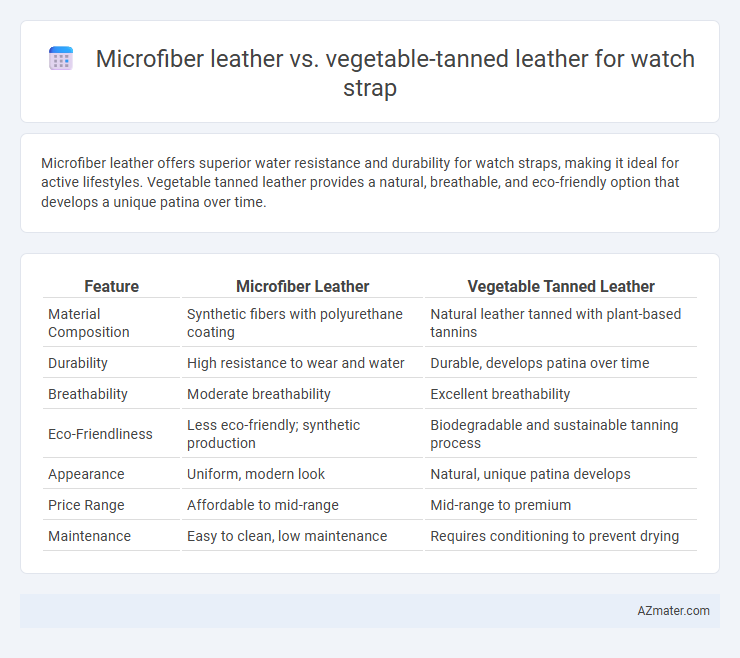Microfiber leather offers superior water resistance and durability for watch straps, making it ideal for active lifestyles. Vegetable tanned leather provides a natural, breathable, and eco-friendly option that develops a unique patina over time.
Table of Comparison
| Feature | Microfiber Leather | Vegetable Tanned Leather |
|---|---|---|
| Material Composition | Synthetic fibers with polyurethane coating | Natural leather tanned with plant-based tannins |
| Durability | High resistance to wear and water | Durable, develops patina over time |
| Breathability | Moderate breathability | Excellent breathability |
| Eco-Friendliness | Less eco-friendly; synthetic production | Biodegradable and sustainable tanning process |
| Appearance | Uniform, modern look | Natural, unique patina develops |
| Price Range | Affordable to mid-range | Mid-range to premium |
| Maintenance | Easy to clean, low maintenance | Requires conditioning to prevent drying |
Introduction to Microfiber Leather and Vegetable Tanned Leather
Microfiber leather is a synthetic material composed of ultra-fine fibers designed to mimic genuine leather's texture and durability, offering water resistance and low maintenance ideal for watch straps. Vegetable tanned leather undergoes a natural tanning process using plant-based tannins, resulting in a firm, breathable, and environmentally friendly material prized for its aging qualities and unique patina over time. Both materials cater to different preferences: microfiber leather focuses on sustainability and practicality, while vegetable tanned leather emphasizes tradition and natural aesthetics.
Composition and Manufacturing Processes
Microfiber leather for watch straps is composed of synthetic fibers bonded with a polyurethane coating, created through a layering and embossing manufacturing process that mimics natural leather textures. Vegetable tanned leather is crafted from natural animal hides treated with tannins derived from plant materials, undergoing a time-intensive soaking and drying process that enhances durability and develops a unique patina. The synthetic composition of microfiber leather offers resistance to moisture and stains, while the vegetable tanning process produces a biodegradable and breathable material favored for its traditional craftsmanship.
Durability: Which Strap Lasts Longer?
Microfiber leather offers superior resistance to water, stains, and scratches, making it highly durable for daily wear, while vegetable tanned leather develops a unique patina over time but is more susceptible to scratches and moisture damage. Vegetable tanned leather generally ages beautifully but requires more maintenance to preserve its integrity, whereas microfiber leather maintains its structure and appearance with less effort. For long-lasting performance and minimal upkeep, microfiber leather watch straps typically outlast vegetable tanned leather under similar conditions.
Comfort and Wear Experience
Microfiber leather offers superior softness and breathability, enhancing comfort during extended wear by reducing sweat buildup and skin irritation. Vegetable tanned leather, while developing a unique patina over time, may initially feel stiffer and less flexible but provides a natural, durable wear experience that molds to the wrist with use. Both materials deliver distinct tactile sensations, with microfiber leather excelling in lightweight comfort and vegetable tanned leather in long-term resilience and character.
Environmental Impact and Sustainability
Microfiber leather for watch straps offers a more sustainable alternative to traditional vegetable tanned leather by reducing reliance on animal hides and minimizing water consumption during production. Vegetable tanned leather involves intensive tanning processes using natural tannins from tree bark and leaves but generates significant waste and requires substantial water and energy resources. Choosing microfiber leather supports lower carbon emissions and decreased chemical use, aligning with environmentally conscious consumer trends.
Aesthetic Appeal and Customization Options
Microfiber leather for watch straps offers a smooth, uniform appearance with consistent color and texture, appealing to those seeking a modern, sleek look; it supports a wide range of customization options including vibrant colors and embossed patterns. Vegetable tanned leather showcases a rich, natural patina that deepens over time, enhancing its aesthetic appeal with unique variations and a classic, vintage character; customization often involves hand tooling and dyeing techniques that reflect artisanal craftsmanship. Both materials provide distinct visual qualities and customizable features suited to different style preferences, with microfiber leather favoring versatility and vegetable tanned leather emphasizing traditional elegance.
Water Resistance and Maintenance
Microfiber leather offers superior water resistance compared to vegetable tanned leather, making it ideal for watch straps exposed to moisture and sweat. Vegetable tanned leather, though aesthetically rich and durable, requires regular conditioning and protection to prevent water damage and staining. Maintenance of microfiber leather is simpler, often needing only a damp cloth for cleaning, while vegetable tanned leather demands specialized treatments to maintain its integrity and appearance over time.
Cost Comparison: Affordability and Value
Microfiber leather watch straps offer a budget-friendly alternative to vegetable tanned leather, with costs typically ranging from $10 to $30 compared to $50 to $150 for vegetable tanned options. While microfiber leather provides affordability and durability, vegetable tanned leather delivers enhanced longevity and develops a unique patina, adding intrinsic value over time. Choosing between the two depends on prioritizing initial cost savings versus long-term investment and aesthetic evolution.
Ideal Use Cases for Each Material
Microfiber leather excels in watch straps for active lifestyles, offering superior water resistance, durability, and easy maintenance ideal for sports and outdoor activities. Vegetable tanned leather is best suited for dress watches, providing a rich patina that develops over time, enhancing elegance for formal and business settings. Choosing between these materials depends on prioritizing practicality and robustness versus classic aesthetics and natural aging.
Final Verdict: Choosing the Best Watch Strap Material
Microfiber leather offers exceptional durability, water resistance, and affordability, making it ideal for active lifestyles and budget-conscious buyers. Vegetable tanned leather provides a unique, natural patina over time, appealing to those seeking authenticity and traditional craftsmanship in their watch straps. Selecting the best material ultimately depends on whether longevity and easy maintenance or natural aesthetics and premium quality are prioritized.

Infographic: Microfiber leather vs Vegetable tanned leather for Watch strap
 azmater.com
azmater.com